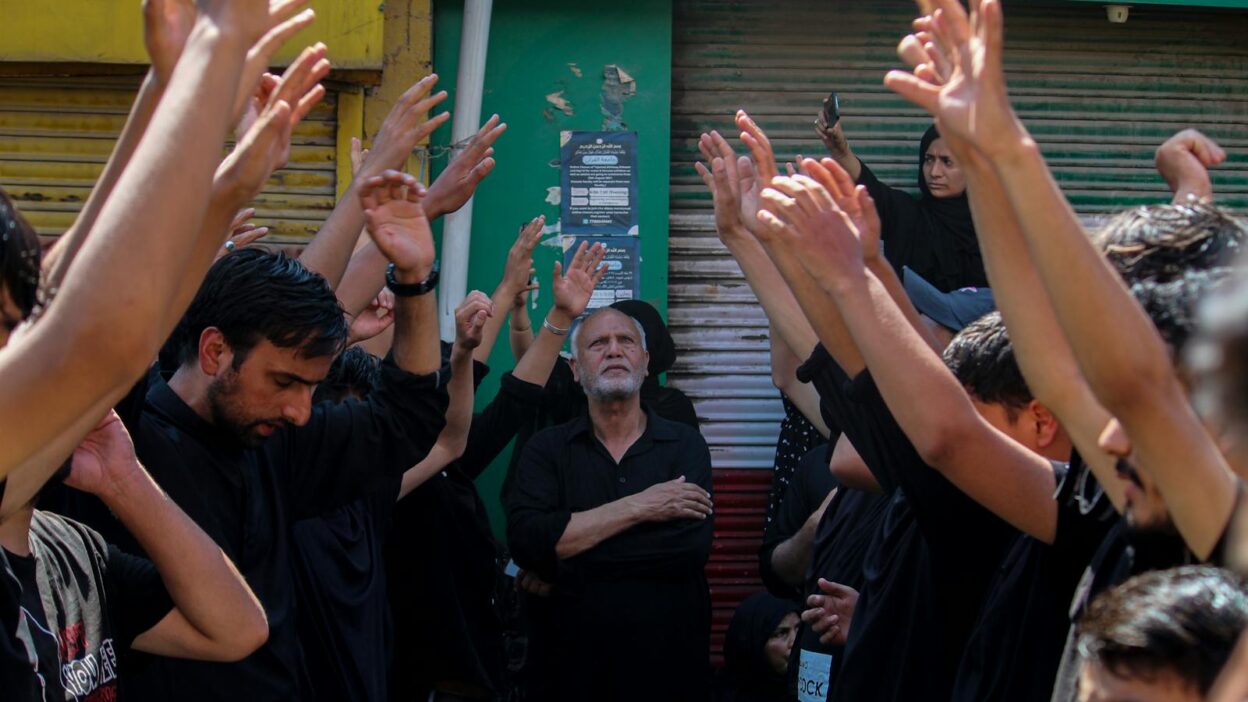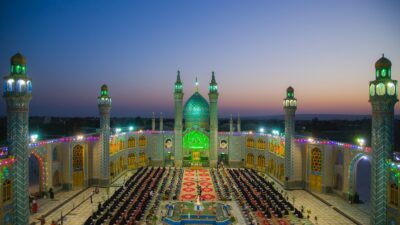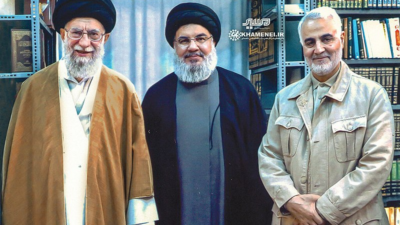Introduction
The brutal massacre of Hussain ibn Ali and his family in 61 AH (after Hijri) had major political and religious ramifications. (see The Martyrdom of Hussain) Politically, Hussain’s martyrdom led to a chain of events that eventually resulted in the overthrow of the Umayyad dynasty and the establishment of the Abbasids. The Abbasid dynasty lasted until 1258 when it was destroyed by the Mongols. From a religious perspective, his death led to the development of Shiasm as a distinct religious sect with concepts and beliefs radically different from their Sunni counterparts.
The Tawwaabeen
Following the martyrdom of Hussain, many of the people of Kufa felt remorse for inviting him to Iraq, and then deserting him in his hour of need. Under the leadership of Sulayman ibn Surad, a hundred Kufans held their first secret meeting in which they vowed to avenge the blood of Hussain by fighting the Umayyads. They called themselves the tawwaabeen (those who repent). After securing the support of 16,000 men, Sulayman ibn Surad decided to launch an attack on the Umayyads. However, of the 16,000 who pledged support, only 4,000 turned up for battle, and this number soon fell to 3,000 men. Undeterred, the tawwaabeen first visited the grave of Hussain where they spent the night mourning before preparing for battle.
In 65 AH the tawwaabeen engaged a 20,000 strong Umayyad army in Ayn al-Warda (a village in southern Syria). Despite being outnumbered almost seven to one, the tawwaabeen fought bravely in a pitched battle that lasted three days. The battle ended with the death of Sulayman ibn Surad. Almost his entire army was wiped out.
 20th-century tile-work in Kermanshah, Iran, depicting the Penitent army. By Coffeetalkh at Persian Wikipedia – Transferred from fa.wikipedia to Commons., GFDL, https://commons.wikimedia.org/w/index.php?curid=31807041
20th-century tile-work in Kermanshah, Iran, depicting the Penitent army. By Coffeetalkh at Persian Wikipedia – Transferred from fa.wikipedia to Commons., GFDL, https://commons.wikimedia.org/w/index.php?curid=31807041
The death of Yazid and the caliphate of Abdullah ibn Zubayr
After the death of the second Umayyad caliph Yazid ibn Muawiya, Abdullah ibn Zubayr declared himself as the Caliph. Ibn Zubayr was not from the Umayyads. Almost the entire Muslim world recognised his caliphate including the Hijaaaz (Western Arabia including Makkah, Madinah, Jeddah), Egypt, Iraq, and almost all provinces in Syria including Damascus. Abdullah ibn Zubayr’s credentials were not in doubt. His father was Zubayr ibn Awwam, one of the ten promised Paradise. His mother Asma bint Abi Bakr was an outstanding figure in the history of Islam, and his maternal grandfather was none other than Abu Bakr as-Siddique . It seemed that Umayyad authority had all but collapsed.
The second civil war
However, a minority of Syrians refused to recognise the caliphate of Abdullah ibn Zubayr, and instead pledged allegiance to Marwan ibn al-Hakam with the intent of continuing the rule of Umayyads. And so began the second civil war which started in 60 AH and ended on 73 AH with the killing of Abdullah ibn Zubayr during the siege of Makkah. During this fitnah, (unrest or rebellion) the Muslim lands were divided between the Umayyads, Zubayrids (i.e., followers of ibn Zubayr), the Khawaarij and Mukhtar al-Thaqafi. It is to the latter we now turn our attention.
See https://commons.wikimedia.org/wiki/File:Second_Fitna_Territorial_Control_Map_ca_686-es.svg for a map of the Islamic world during the second civil war.
Mukhtar al-Thaqafi
The Prophet (ﷺ) said: ‘In Thaqif there is a liar and a destroyer’.
Mukhtar al-Thaqafi rose to prominence after the martyrdom of Hussain. His father in-law was the Sahaabah Numan ibn Bashir who at one time was the governor of Kufa. Prior to the fateful trip of Hussain ibn Ali to Iraq, Yazid ibn Muawiya sacked Numan ibn Bashir and replaced him by Ubaydullah ibn Ziyad who then executed Muslim ibn Aqeel (Hussain’s representative in Iraq).
Upon the death of Yazid, Mukhtar pledged allegiance to the Caliph Abdullah ibn Zubayr. He then travelled to Kufa where he began calling for revenge against the killers of Hussain. Once he had galvanised enough support, he led a rebellion against Abdullah ibn Zubayr’s Iraqi governor. Soon most of Iraq came under his control. Mukhtar began executing anyone who was suspected of involvement in Hussain’s killing. There wasn’t a single house left in Kufa except that Mukhtar had someone executed in it. As a result, many Kufans fled to Basra, another major city in Iraq. In response, Ubaydullah ibn Ziyad (who was responsible for Hussain’s murder) led army on behalf of the Umayyads to attack Mukhtar. In 67 AH the two sides clashed in Mosul, resulting in the defeat and killing of Ibn Ziyad. During this battle, Mukhtar’s followers carried what they claimed was the chair of Ali ibn Abi Talib, and sought assistance through it.
Up until now, Shiasm was primarily a political movement. Its followers, who were mainly based in Iraq, had a strong allegiance to Ali ibn Abi Talib and his progeny. Although the sources do mention a group called the Saba’iyya who believed in the divinity of Ali and his divine appointment as the Imam, their influence up until now was very limited. As caliph, Ali ibn Abi Talib executed a large number of them. The Saba’iyya were amongst the supporters of Mukhtar. As we shall see, Mukhtar was successful in introducing new religious concepts which were eventually absorbed into mainstream Shiasm. The Prophet (ﷺ) foretold this in the following hadith: “In Thaqif there is a liar and a destroyer”. (at-Tirmidhi). The liar in this hadith refers to Mukhtar and the destroyer refers to Hajjaj b Yusuf who killed Abdullah ibn Zubayr.

A view of modern-day Kufa, the headquarters of Mukhtar, and its Great Mosque, where his grave is located. By Karbobala Photos – http://karbobala.com/news/info/2094/گالری-تصاویر-از-مسجد-کوفه, CC BY 4.0, https://commons.wikimedia.org/w/index.php?curid=63406466
Mukhtar and the ‘Mahdi’
Ali ibn Abi Talib was father to 39 children, the most famous of them being Hassan and Hussain due to their direct lineage to the Prophet (ﷺ). One Ali’s sons was named Muh̩ammad b. al-Ḥanafiyya. He had chosen not to accompany Hussain on his fateful journey to Iraq and instead remained in Madina.
On his return to Kufa, Mukhtar propagated the belief that Ibn al-Ḥanafiyya was the divinely guided Imam, the Mahdi and the son of the Prophet’s religious heir (i.e. Ali ibn Abi Talib), and that he was his chosen representative in Iraq. The Imam – Mahdi would lead his followers in a battle against tyranny and establish justice on earth. These terms, popularised by Mukhtar were to later become a cornerstone of Shia belief. As the representative of the living Mahdi, Mukhtar would convey the latter’s teaching to his followers in Iraq. A fabricated a letter from Ibn al-Hanfiyya to Mukhtar gave the latter more credence. With these newly innovated beliefs coupled with a call for vengeance against the killers of Hussain , Mukhtar was able to build up huge following. Shiasm was now evolving from a political movement to a religious sect with a set of beliefs that distinguished it from Sunni Islam.

Tile-work in Kermanshah depicts Mukhtar overseeing the punishments of those involved in the killing of Husayn ibn Ali. By Coffeetalkh at Persian Wikipedia – Transferred from fa.wikipedia to Commons. [1] isna.ir, GFDL, https://commons.wikimedia.org/w/index.php?curid=31809151
Defeat of Mukhtar
In Basra, the refugees who had fled from Muktar’s persecution in Kufa persuaded its governor Mus’ab ibn Zubayr to attack Kufa. In the ensuing battle Mukhtar’s army was heavily defeated. In 61 AH Mukhtar was killed and his supporters executed. Thus, Iraq came under the control of Abdullah ibn Zubayr. The latter was eventually defeated by the Umayyads in 73 AH.
Although Ibn al-Ḥanafiyya was the key figurehead for Mukhtar’s movement, there is no evidence that he supported Mukhtar, nor did he play any role in his revolt. After Mukhtar’s death (and the defeat of Ibn Zubayr), Ibn al-Ḥanafiyya pledged allegiance to the Umayyad Caliph Abdul Malik ibn Marwan.
Mukhtar’s legacy
Many of the ideas of Mukhtar continued after his death by a group called Kaysaaniyya. Their name is derived from Abu Amra Kaysaan who was Mukhtar’s bodyguard. The term Kaysaaniyya refers a number of different groups that emerged following the revolt of Mukhtar. Rejecting the caliphates of Abū Bakr, ‘Umar and ‘Uthman, they recognised four Imams; ‘Ali b. Abī Talib, Ḥasan, Ḥussain, and Muh̩ammad ibn al-Ḥanafiyya. The Kaysaaniyya held that ‘Ali was the divinely appointed successor to the Prophet, and thus Abu Bakr was a usurper and a disbeliever.
Early Shiasm
Upon the death of Ibn al-Ḥanafiyya in 81 AH, the Kaysaaniyya were divided into a number of groups. Some believed that he had not died but gone into hiding/occultation (ghayba) in the gorges north of Madina, guarded by lions and tigers. He would soon return (raj’a), and along his followers, fill the earth with justice. These two concepts were later adopted by mainstream Shī‘as. The Kaysaaniyya accounted for the majority of the early Shī’ī groups until the ‘Abbasid revolution. Eventually as a group Kaysaniyya died out, and their beliefs were absorbed into what was to become mainstream Shiasm.
The Abbasid revolution
Others from the Kaysaaniyya believed that following the death of Muh̩ammad b. Ḥanafiyya, the Imamate had been transferred to his son Abu Hashim. Upon Abu Hashim’s death, the majority of his followers, known as the Hashimiyya believed that he had appointed his ‘Abbasid relative, Muh̩ammad b. ‘Alī (the great-grandson of ‘Abbas- the Prophet’s ﷺ uncle) as his successor. The ‘Abbasids thus inherited a Shī’ī movement, and used these Shī’ī sentiments to agitate against and in 132 AH finally overthrow the Umayyads.
A comparison between the Kaysaniyya and the Ithnā-‘Ashariyya
|
Muk̲h̲tār al-Thaqafi and the Kaysāniyya |
Ithna-‘Ashariyya (twelver sect of Shiasm) |
|
Existed from 65 AH to 100 AH (approximately) |
Existed from 300 AH approx. to present day (with several modifications in belief during this period) |
|
Four infallible Imams: Ali, Hassan, Hussain, Ibn al-Ḥanafiyya |
Twelve infallible Imams; from Ali b. Abi Talib to Muḥammad ibn al-Ḥasan |
|
Fourth Imam is the Mahdi |
Twelfth Imam is the Mahdi |
|
Fourth Imam is in hiding (ghayba) |
Twelfth Imam is in hiding (ghayba) |
|
Fourth Imam will return (raj’a) and fill the world will justice |
Twelfth Imam will return (raj’a) and fill the world will justice |
|
The first three caliphs were illegitimate usurpers |
The first three caliphs were illegitimate usurpers |
The table above shows that the creed of today’s Ithna-‘Ashariyya Shia is derived from Muk̲h̲tār al-Thaqafi and his followers called the Kaysaaniyya.
Conclusion
The outpouring of grief following the martyrdom of Hussain was cleverly exploited by the shrewd and charismatic Mukhtar al-Thaqafi. Calling for vengeance against the killers of Hussain, he and his successors innovated a number of concepts [Imamate- Mahdi, occultation (ghayba) and return (raj’a)] which were to later become central tenants of Shiasm.
Mukhtar’s movement eventually led to the overthrow of the Umayyads at the hands of the Abbasids. They based their claim to legitimacy by stating that Abu Hashim, son of Ibn al-Ḥanafiyya had transferred the Imamate (leadership) to Muh̩ammad b. ‘Ali, the great-grandson of ‘Abbas. The son of Muhammad b. ‘Ali, was known as al-Saffah (blood shedder). He became the first caliph of the Abbasids.
References
Ibn Kathir, Al-Bidayah wa Nihayah
Najeebabadi. A.S., History of Islam (Darasalam, 2002)
Hawting, G.R., “al-Muk̲h̲tār b. Abī ʿUbayd”, in: Encyclopaedia of Islam, Second Edition
Daftary, F, The Isma’ilis: Their History and Doctrines (Cambridge: Cambridge University Press, 2007)
Sachedina, A, Islamic Messianism: The Idea of Mahdi in Twelver Shi’ism (Albany: SUNY Press, 1981)
Anthony, S, The Caliph and the Heretic: Ibn Sabaʾ and the Origins of Shīʿism (Leiden: Brill, 2011)
Halm, H, Shi’ism (Edinburgh: Edinburgh University Press, 2004)





